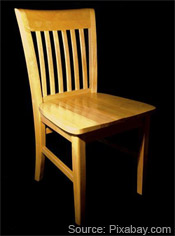Wood furniture is beautiful, but can become easily scratched, soiled, chipped, or smudged. The best way to keeping your furniture lustrous, spotless and shining depends on the type of wood and finish. Always make sure to use the appropriate products for your piece, and call wood furniture retailer or antiques dealer if you have any doubts.

Cleaning the Wood
- Dusting. Keeping your wood clean starts with frequently removing the dust and debris that collects on the surface. Deposits and filmy build-up can make your wood look dirty, dull, and eventually cause scratches to form. Use a clean, dry cloth to gently wipe dust off of your wood furniture regularly.
- Cleaning spots or stains. Wood finish is sensitive, and cannot be cleaned with just any product. All-purpose cleaners should be avoided, because they can ruin the finish and make your wood appear dull, or leave behind a sticky film. While you want to avoid using water on the wood, if something spills or there's residue on the surface, wipe the area clean with a soft cloth dampened with a mild soap and water mixture. Follow-up up with a second damp cloth to rinse and dry immediately with a third, dry cloth.
- A deep clean. If you are restoring an old garage store find, or repurposing a forgotten table left in your basement, you may need something a little stronger to cut through years of caked-on grime. Concoct a mixture using oil soap and water, then rinse and dry well. If the wood still appears unclean, gently scrub with an extra-fine steel wool dipped with a wood-safe cleaning product. Avoid mixtures containing linseed oil, turpentine, or white vinegar. End with a coat of clear paste wax for protection.
Waxing and Polishing the Wood
Most wood furniture is covered with varnish, polyurethane, or shellac finish to protect the surface from scratches or chips. Periodically applying furniture wax or polish will help maintain the finish, protect your wood and restore its lustrous shine.
- Wax. Applying wax to your wood furniture is ideal because it provides a hard finish, better protection and won't smudge or smear like furniture polish. It's longer-lasting, too--paste or liquid wax made specifically for furniture can last as long as two years. While liquid wax is easier to apply, it is thinner and may need to be applied more often than paste wax.Apply wax in light coats, rubbing it gently into the wood and moving with the grain to prevent streaks, smudges or cloudiness. After the wax dries, buff gently with a soft cloth to create a bold shine.
- Oils and polish. While oil and polish can help protect wood by making the surface slick and reducing scratches, they will not create a hard, protective finish as wax will. Also, if you use a product that is too concentrated or oily (such as pure olive oil), the surface may smear, show fingerprints, or attract dust. Opt for a commercial, furniture spray or liquid polishes containing silicone oil, which will provide some protection.
Repairing Scratches
Unsightly scratches, chips, or gouges in your wood furniture can ruin its appearance. For light surface scratches, you may be able to treat the problem with paste wax or a felt-tip pen in a similar color. Cutting a walnut in half and rubbing the oils over the scratch is also a common tactic used to reduce the offensive mark's appearance.
For deeper gouges, cracks, or chips, you will need to use wood filler or a wax stick purchased at home goods retailer. Make sure to match the filler or the stick as closely as possible to your wood-they are available in a variety of colors to match almost any type of wood or stain. Apply the stick by pressing the tip into the defect and drawing over the area, or apply the filler using a putty knife. Wipe away excess of either materials with the putty knife and sand down until smooth.
Maintenance by Wood type
Caring for your furniture will also depend on the type of wood from which it's made.
- Oiled wood
- You should never wax furniture with an oil finish. It can turn it dry and brittle.
- To remove water rings and stain, rub a little toothpaste on the area with a clean, dry cloth. You can also try using an abrasive such as baking soda, salt, pumice and then following with olive oil or petroleum jelly.
- Painted wood
- Avoid using polish and wax on painted wood-it can cause discoloration.
- To clean, dust the furniture and wipe periodically with a damp sponge to remove fingerprints and other smudges.
- Polished woodPolished wood is any furniture treated with wax, lacquer, or varnish to protect its surface. When polishing your wood, always choose a product appropriate for the type of finish.
 Sprinkle cornstarch on your newly-polished wood furniture's surface and gently rub to absorb excess oil and leaves a beautiful, smudge-free gloss.
Sprinkle cornstarch on your newly-polished wood furniture's surface and gently rub to absorb excess oil and leaves a beautiful, smudge-free gloss.- To eliminate water rings on polished furniture, wipe a little mayonnaise to the white rings or on the area, leave on about an hour, then wipe clean with another cloth. Finish with polish.
- Specialty wood. These include wicker, rattan, cane, and bamboo. They usually have a simple natural finish, but some may be coated with varnish or shellac.
- Clean specialty wood by frequently dusting or vacuum using a brush attachment.
- Rinse specialty woods occasionally with water to restore moisture to the fibers.